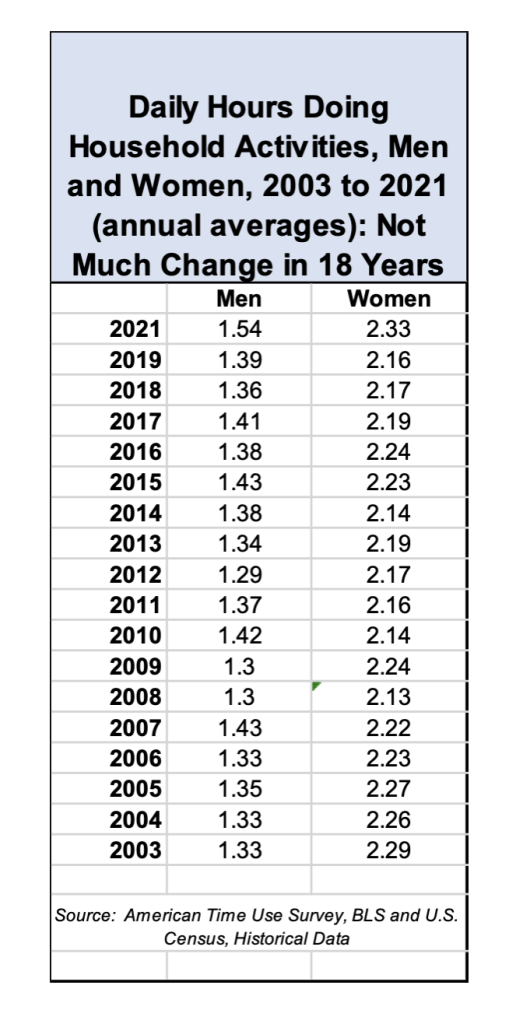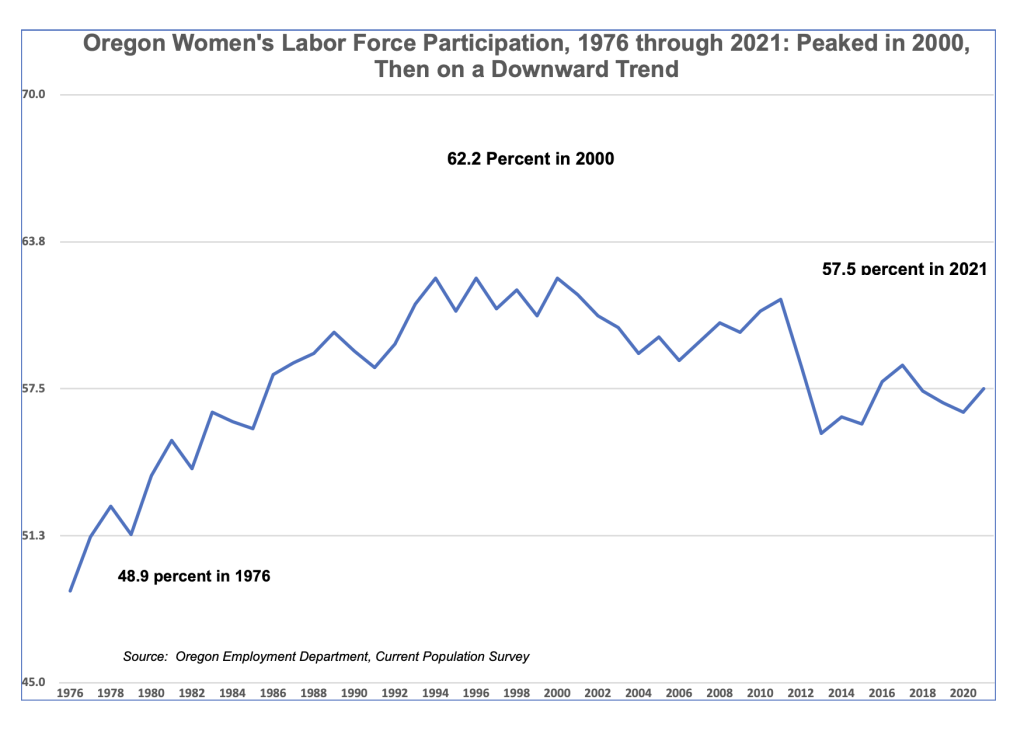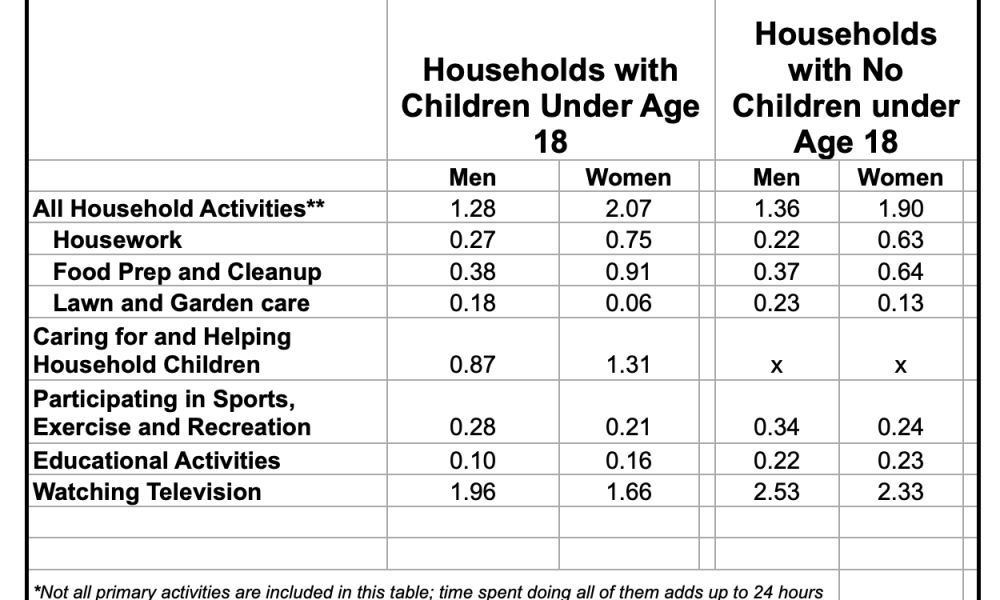Working women with children had an especially rough time during the pandemic. That’s true in the Salem area, Oregon, and the U.S. as a whole. Lack of affordable quality day care was a major stressor for moms working outside the home for pay. Evidence of an added stressor is found in the latest results from the American Time Use Survey. Women, even when working outside the home, still performed the major share of household chores including caring for children.
2021 survey results were released a month ago. Women spent an average of two hours or more daily on household chores, and men, about an hour and a third. This pattern, with slight variation, has held up for the last 18 years (see table below).

The survey, a joint venture of the federal Bureau of Labor Statistics and the U.S. Census, was begun in 2003. Every year, approximately 9,000 individuals aged 16 and older are interviewed about their time use on a specific day. The day is chosen in advance so that the interviewee can track their time in a manner carefully described by survey protocol. Activities on each day of the week are represented in the survey days, including weekends. Responses are then carefully coded, and the result is a great deal of detailed information about how Americans spend their time.
Let’s look at some results from 2021. Specifically, we’ll look at the time use of employed households (where both men and women are employed), with and without children under the age of 18 (table at top of story).
Overall results were similar to the historical averages, in that women still did more, and some of the detail is interesting:
- Women spent more time on household chores than men in households with children under 18 – this includes housework, food prep and cleanup, and caring for children
- Women also spent more time on household chores than men in households without children under 18
- The only household chore on which men spent more time than women is lawn and garden care
- Women spent slightly more time on average on educational activities than men, in households with and without children
- Men spent more time than women on sports, exercise and recreation, and watched more TV, than women, in households with and without children
- And in employed households with no children under age 18, men and women spent less time on household chores, and more time watching television, than in households with children under age 18
There is also detail on weekend time use. Men spent a bit more time, overall, on household chores on weekends than they did on average of all seven days. However, women still did the major share of household chores on weekends.
It should be noted that, with some minor variations, the patterns displayed above in the differences between men and women’s time spent on household chores has held up for the 18 years of the Time Use survey.
The survey contains much more detail than is described here, and to see more, here is the link to the 2021 survey results.
Why is all this important? Because women’s labor force participation has been declining since about the year 2000. It has declined even among college-educated women, which is noteworthy because higher levels of education usually mean higher levels of labor force participation (see graph below).

Women’s labor force participation declined during Covid. With schools closed and day care scarce, working mothers faced stressful choices -stay home with the children, leave their jobs and lose needed income – or – if they were fortunate enough to be able to work from home, doing that with the added responsibility of caring for children.
The American Time Use Survey was not administered during 2020, due to survey difficulties in the first year of Covid. But the Bureau of Labor Statistics administered the Household Pulse Survey, specifically designed for the covid economy. According to the Pulse survey, if women worked from home, they performed the major share of at-home educational activities with their children. Some women did quit their jobs.
Women’s participation has now recovered to pre-pandemic levels. However, their current participation rate of 57.5% is nearly five percentage points lower than in the year 2000, and is paltry compared to participation in many other industrialized countries.
Norway takes the prize, where 80% of women participate in the labor force, according to a Standard and Poor’s study of OECD countries (Organization for Economic Cooperation and Development). This means that 8% of the female civilian population over the age of 16 is either working or looking for work. Standard and Poor’s estimates that if U.S. women participated in the labor force similarly to Norway, 1.3 trillion dollars would be added to U.S. gross domestic product; $5,000 for every man, woman and child in the U.S.
Women in OECD countries do the major share of the housework, as in the U.S. But many OECD countries directly subsidize day care for working parents, and overall, have more family-friendly labor market policies – the U.S. is the outlier here.
We probably shouldn’t expect government to subsidize men doing household chores. But some help with day care for working moms and dads could bring women’s labor force participation up, bring more job applicants to employers’ doors, and add to household incomes, and to the gross domestic product as well.
It is unlikely that working women doing more housework than men is a major cause of declining women’s labor force participation – after all, it’s been the case for many years, even when women’s labor force participation was increasing. But understanding all the factors that might contribute to the decline is important, because the economy is losing out on a sizable and talented labor force.
Pam Ferrara of the Willamette Workforce Partnership continues a regular column examining local economic issues. She may be contacted at [email protected].
JUST THE FACTS, FOR SALEM – We report on your community with care and depth, fairness and accuracy. Get local news that matters to you. Subscribe to Salem Reporter starting at $5 a month. Click I want to subscribe!

Pamela Ferrara is a part-time research associate with the Willamette Workforce Partnership, the area’s local workforce board. Ferrara has worked in research at the Oregon Employment Department, earned a Master’s in Labor Economics, and speaks fluent Spanish.









